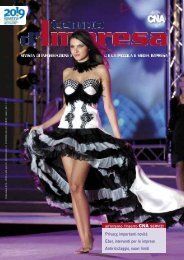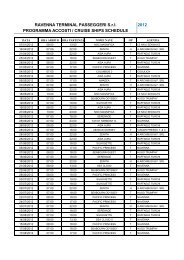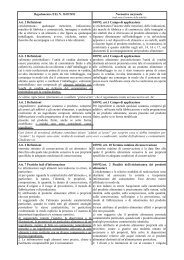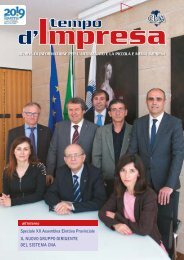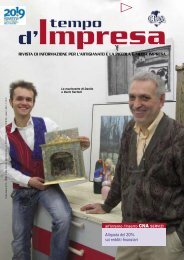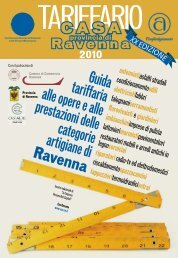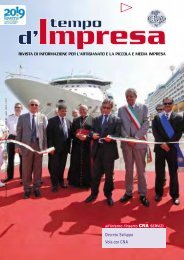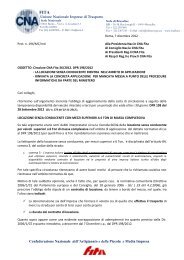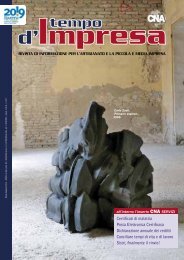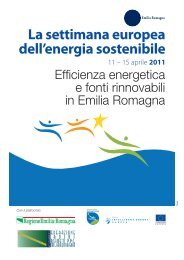Create successful ePaper yourself
Turn your PDF publications into a flip-book with our unique Google optimized e-Paper software.
Cucina marinara<br />
Locale climatizzato<br />
Apertura annualenuale<br />
Per il periodo della mostra,<br />
il ristorante “il Veliero”<br />
propone il menù ù degustazione<br />
al costo di 25 Euro.<br />
Si consiglia la prenotazione<br />
Via Nazzario Sauro, 124<br />
Cervia Borgo Marina<br />
Tel. 0544 72009<br />
Fax 0544 972130<br />
E-mail info@ristoranteilveliero.com<br />
SOMMARIO<br />
Elisa Grillini<br />
4<br />
Marco Minnozzi<br />
14<br />
Gianni Fabbri<br />
Ceramiche Boschi<br />
5<br />
6<br />
Bottega Giordano<br />
Pico<br />
15<br />
16<br />
Associazione Provinciale<br />
di <strong>Ravenna</strong><br />
Giovanni Martini<br />
Isacco Vassura<br />
7<br />
8<br />
Arte del Restauro<br />
Enzo Scianna<br />
17<br />
18<br />
COMUNE DI CERVIA<br />
Laura Silvagni<br />
9<br />
Fos<br />
19<br />
Antonio Vicentini<br />
10<br />
C’era una volta<br />
20<br />
Liliana Ricciardelli<br />
11<br />
Stefano Foschini<br />
21<br />
Ceramiche l’Odissea<br />
12<br />
Egidio Miserocchi<br />
22<br />
Ferro Arte Arredo<br />
13<br />
P.R.P.<br />
23<br />
Realizzato da:<br />
2
L’Artigianato Artistico<br />
ai Magazzini del Sale<br />
Natale a<br />
Cervia<br />
Non è facile unire in una stessa mostra le lavorazioni di artigianato artistico, di studi d’arte e<br />
botteghe che rappresentano settori così differenti tra loro, ma capaci nell’insieme di dare una<br />
rappresentazione del sapere, della professionalità e della qualità artistica che l’artigianato della<br />
nostra provincia sa rappresentare.<br />
I pezzi e le singole opere in esposizione sono il frutto di un lavoro di artigianato che si apprende<br />
con studio e passione, risultato di una continua ricerca nelle botteghe e negli studi d’arte che<br />
mantengono viva la tradizione di mestieri che hanno dato identità e valore alla produzione di<br />
artigianato artistico del nostro Paese.<br />
Una mostra che si espande in un gioco di luci, di colori, di forme tanto diverse tra loro, una<br />
occasione per vedere assieme il risultato del lavoro di ceramisti, restauratori, mosaicisti, fabbri,<br />
decoratori di tela stampata, mosaicisti a cui va il nostro ringraziamento per l’impegno che<br />
hanno profuso anche nell’organizzazione di questa mostra, ospitata per la prima volta nelle<br />
belle sale dei magazzini del sale.<br />
Vogliamo cogliere l’occasione per ringraziare il Comune dei Cervia per l’ospitalità che ci è stata<br />
data, la Camera di Commercio di <strong>Ravenna</strong> per il sostegno e l’attenzione data all’organizzazione<br />
della mostra.<br />
Un ringraziamento infine alla <strong>CNA</strong> della Provincia di <strong>Ravenna</strong> ed agli sponsor che col loro<br />
contributo hanno permesso di giungere alla realizzazione di una mostra che allieterà le festività<br />
natalizie di Cervia.<br />
L’Unione Artistico e Tradizionale della <strong>CNA</strong> Provinciale di <strong>Ravenna</strong><br />
A tutti i visitatori i migliori Auguri di un Felice 2008<br />
Artistic Handicrafts at the<br />
“Magazzini del Sale ”<br />
Christmas in Cervia<br />
It is no easy task to bring together the work of artistic craftsmen, art studios and workshops in the<br />
same exhibition because they represent such different sectors. But when they all come together,<br />
they provide an overview of the knowledge, professionalism and high artistic quality that our<br />
province proudly boasts.<br />
Each exhibit is the result of years of hard work and passion, of on-going research in workshops<br />
and art studios, keeping these traditional professions alive, professions that have put our<br />
country’s artistic handicrafts on the map.<br />
Visitors cannot help but admire the host of different lights, colours and shapes in the exhibition<br />
and it is a great opportunity to enjoy the collective work of ceramic workers, restorers, mosaicists,<br />
blacksmiths and cloth printers and decorators. A big “thank you” goes to them for all their hard<br />
work in organising this exhibition that, for the first time ever, is held in the beautiful rooms of the<br />
“Magazzini del sale” (the town’s traditional salt store).<br />
We would like to take this opportunity to thank the Municipality of Cervia for its hospitality and<br />
<strong>Ravenna</strong>’s Chamber of Commerce for its support and assistance in organising the exhibition.<br />
And lastly our thanks go to the <strong>CNA</strong> of the province of <strong>Ravenna</strong> and the sponsors who, with<br />
their contribution, have enabled us to put on an exhibition that will add to the Christmas cheer<br />
in Cervia this year.<br />
The Artistic and Traditional Union of <strong>Ravenna</strong>’s <strong>CNA</strong><br />
A very happy 2008 to all our visitors<br />
3
Elisa Grillini<br />
Via Gaggio, 12 - Budrio di Cotignola<br />
Tel. 0545 79509<br />
Cell. 335 296342<br />
www.elisagrillini.it<br />
Elisa Grillini nata a Cotignola (<strong>Ravenna</strong>), ha conseguito il<br />
diploma nel 1984 presso l’Istituto d’Arte per la Ceramica “G.<br />
Ballardini” di Faenza (Ra). Nei primi anni della sua carriera,<br />
nonostante un’esperienza nel settore della ceramica industriale<br />
a Modena, e nel settore della grafica pubblicitaria a Ferrara,<br />
coltiva la passione per la ceramica artistica esponendo le sue<br />
prime creazioni in mostre nazionali nelle città di: <strong>Ravenna</strong>,<br />
Ferrara, Firenze, Trieste, Udine. Nel 1993 decide di dedicarsi<br />
esclusivamente all’arte della ceramica artistica aprendo<br />
a Lugo (Ra) il suo laboratorio. In questi anni Elisa Grillini ha<br />
confrontato il suo lavoro con esperienze all’estero attraverso<br />
seminari in Spagna. Nel campo sociale è intervenuta creando<br />
un laboratorio di ceramica nel centro di formazione “Padre<br />
Leo commissari” a San Paolo in Brasile con la collaborazione<br />
del Comune di Lugo. L’obbiettivo è stato quello di trasmettere<br />
sia la passione sia la cultura, attraverso un soggiorno in Brasile necessario per svolgere corsi di formazione<br />
ai ragazzi delle favelas. Elisa Grillini inoltre, come docente, si impegna con Istituti d’Arte, organizza stage di<br />
formazione all’interno del proprio laboratorio e collabora con Enti Regionali svolgendo attività di ceramica<br />
all’interno di laboratori protetti.<br />
Elisa Grillini was born in Cotignola (<strong>Ravenna</strong>). She studied at the “G. Ballardini” (Ceramic Art Institute)<br />
in Faenza (<strong>Ravenna</strong>) and received her diploma in 1984. In spite of considerable experience in the field of<br />
industrial ceramics in Modena and advertising graphics in Ferrara, she nurtured her love of artistic ceramics<br />
in the first few years of her career. She displayed her first creations in various exhibitions in Italian cities such<br />
as <strong>Ravenna</strong>, Florence, Trieste and Udine. In 1993 she decided to fully dedicate herself to artistic ceramics<br />
and opened a workshop in Lugo (<strong>Ravenna</strong>). During this time, the artist also spent time abroad attending<br />
seminars in Spain. She has also donated a considerable amount of time and energy on a social front. She<br />
started a ceramics workshop in San Paolo, Brazil, backed by the municipality of Lugo. Her goal was to<br />
convey her passion and skill to those less fortunate by spending time in Brazil and teaching young people<br />
from the favelas, or hillside shantytowns. Elisa Grillini now also works with several Art Institutes, where through<br />
work experience programs, she follows the training of students in her workshop. She also works with Regional<br />
Government offices, by running ceramic workshops in drug rehabilitation<br />
centres.<br />
4<br />
Elisa Grillini<br />
info@elisagrillini.it
Gianni Fabbri<br />
Via Baroncini, 9<br />
48018 Faenza (RA)<br />
Tel e fax: 0546/20044<br />
Gianni Fabbri ha da sempre avuto la passione per le attività<br />
artistiche, inizia frequentando la Scuola di Disegno Tommaso Minardi<br />
di Faenza e poi il Centro di Addestramento Professionale. Nel 1972<br />
apre a Faenza una bottega per la lavorazione di materie plastiche<br />
e metalli per pubblicità e arredamento. Negli anni ’90 si avvia all’uso<br />
del plexiglas, materia straordinaria per sculture e pannelli luminosi<br />
che arredano creando nell’ambiente un fascino particolare.<br />
Gianni Fabbri has always been passionate about art. He started<br />
his career at the Tommaso Minardi School of Design in Faenza,<br />
followed by the Centre for Professional Training.<br />
In 1972 he opened a workshop in Faenza, producing plastic and<br />
metal works for the world of advertising and furnishing. In the<br />
Nineties he started using plexiglass, an amazing material used<br />
in sculptures and neon panels that create an atmosphere and<br />
unique charm wherever they are placed.<br />
Gianni Fabbri<br />
fabbriscultureluminose@gmail.com<br />
5
Ceramiche Boschi<br />
Via Cavour 8/B<br />
48018 Faenza (RA)<br />
Tel e fax: +39 0546 22256<br />
Cell. 333 1110283<br />
www.ceramicheboschi.it<br />
Dopo gli studi presso l’Istituto Statale d’Arte per la Ceramica di Faenza<br />
“G.Ballardini”, durante i quali ha vinto anche il primo premio del “Concorso<br />
Internazionale della Ceramica” destinato agli studenti dell’Istituto d’Arte,<br />
Cesare Boschi ha lavorato per lo scultore Angelo Biancini ed ha insegnato<br />
arti applicate all’Istituto Statale d’Arte di Bologna e disegno professionale<br />
all’Istituto d’Arte di Faenza. Nel 1976 ha aperto la sua bottega dove si<br />
realizzano maioliche artigianali smaltate e decorate a mano secondo<br />
l’antica tradizione faentina. Tra i lavori più importanti di Cesare Boschi va<br />
ricordato il grande pannello in maiolica, formato da 460 piastrelle, raffigurante<br />
episodi della vita della Madonna, collocato nella Chiesa dei Passionisti a<br />
Sant’Arcangelo di Romagna. Dal 1980 ha partecipato, ogni anno, alla mostra<br />
Estate Ceramica di Faenza ed alle iniziative organizzate dall’Ente Ceramica in<br />
Italia e nel mondo.<br />
After completing his studies at the<br />
“G. Ballardini” National Ceramic Art<br />
Institute in Faenza, during which he<br />
w o n the first prize of the international ceramics<br />
competition addressed<br />
to the students of the Institute, Cesare<br />
Boschi worked for the sculptor Angelo Biancini and he<br />
taught applied arts at<br />
the National Art Institute in Bologna<br />
and professional design at the Art Institute in Faenza. In 1976 he opened his own workshop,<br />
where he still produces artisan faience majolica, glazed and hand painted according to the ancient<br />
tradition of Faenza. One of the most important works of Cesare Boschi to be remembered is the great<br />
faience majolica panel, made of 460 tiles depicting episodes of the life of the Virgin Mary, situated in the<br />
Church of the Passionists in Sant’Arcangelo di Romagna. Since 1980, he has taken part in the exhibition<br />
“Estate Ceramica” of Faenza and in the initiatives organised by the Ente Ceramica, both in Italy and in<br />
the world.<br />
6<br />
Ceramiche Boschi<br />
info@ceramicheboschi.it
Giovanni Martini<br />
Via Molino, 33<br />
Fusignano (RA)<br />
Tel. 0545/52606<br />
Nato a Bagnacavallo (RA) il 15 Settembre 1944. Artista<br />
autodidatta, sin da giovane s’interessa alle arti plastiche,<br />
modellando l’argilla e creando modelli di attrezzi agricoli. All’età<br />
di quindici anni inizia a lavorare il ferro, dedicandosi all’attività<br />
di carpentiere. Nel 1969 frequenta il corso di pittura di Umberto<br />
Folli a Massalombarda. All’inizio degli anni Settanta, l’incontro<br />
con Luigi Soldati è decisivo nella scelta di sperimentare il ferro<br />
da un punto di vista artistico.<br />
Dal 1983 lo scultore porta avanti l’attività artigianale e artistica<br />
nel suo laboratorio di Fusignano, in uno splendido mulino<br />
restaurato del Cinquecento.<br />
Come per magia prendono forma certi piatti, certi bacilli, certi<br />
crateri: con le loro levigate rotondità e le ritmiche increspature,<br />
le morbide puntinature, gli sfumati riverberanti di luce e di<br />
colore, si presentano ai nostri occhi con tutta la soavità, la<br />
delicatezza, la leggerezza, il morbido tessuto d’una preziosa<br />
manifattura ceramica.<br />
Giovanni Martini was born in Bagnacavallo (<strong>Ravenna</strong>) on 15th<br />
September 1944. He is a self-taught artist and from an early age<br />
was interested in plastic arts, modelling clay and creating models<br />
of farm tools. When he was fifteen, he started working with iron,<br />
becoming an apprentice metalworker. In 1969 he attended a<br />
painting course held by Umberto Folli in Massa Lombarda. At the<br />
beginning of the Seventies, a meeting with Luigi Soldati was to<br />
prove decisive as it led him to choose to experiment artistically<br />
with iron.<br />
In 1983 he set up his workshop in a splendid renovated 16th<br />
century mill in Fusignano, where he still produces his artistic<br />
sculptures.<br />
His plates and small and large bowls take shape almost by magic:<br />
with their polished roundness and rhythmic rufflings, gentle dots<br />
and shades reflecting light and colour, they appear with all the<br />
sweetness, delicacy, lightness and softness of a<br />
precious ceramic object.<br />
Giovanni Martini<br />
7
Isacco Vassura<br />
Via Dogana, 12<br />
48018 Faenza<br />
Tel. 0546/20078<br />
Isacco Vassura (Faenza, 1972) svolge l’attività di restauro, alla quale<br />
affianca la produzione di opere artistiche, dipinti a olio su tavole lignee.<br />
Dal 1996 svolge attività espositiva, concretizzatasi in diverse personali e<br />
collettive. Nel 2004 ha vinto il primo premio del concorso “L’uomo e il suo<br />
ambiente”. Odette Gelosi ha scritto su “Il Corriere di Romagna”: “…come,<br />
infatti, non scoprire nelle positure delle figure-sovente presentate , se nude,<br />
o quasi, di schiena o in atteggiamenti singolari di sottrazione del volto allo<br />
sguardo dell’osservatore-sensazioni e intenti scaturiti dall’io profondo di<br />
Vassura. L’eleganza e la potenza del segno determinano l’ efficacia di<br />
ognuno di questi lavori, suscitando così un’emozione estetica che solo un<br />
vero artista riesce ad infondere”.<br />
Isacco Vassura (Faenza, 1972)<br />
is both a restorer and artist,<br />
producing oil paintings on<br />
wooden panels. He started<br />
exhibiting in 1996 and has held<br />
several one-man and collective<br />
exhibitions. In 2004 he won first<br />
prize in the competition “L’uomo<br />
e il suo ambiente” (“Man and<br />
his environment”). Odette Gelosi wrote the<br />
following about him in “Il Corriere di Romagna”: “…as, in fact, not in<br />
the postures of the nude or semi-nude figures he often portrays who<br />
have their backs to the observer or strangely try to avoid his eye -<br />
sensations and purposes that come from Vassura’s innermost ego.<br />
The elegance and power of his strokes determine the effectiveness<br />
of each of these works, stirring up an aesthetic emotion that only a<br />
real artist can convey”.<br />
8<br />
Isacco Vassura
Laura Silvagni<br />
Via S. Ippolito, 23/A<br />
48018 - FAENZA (RA)<br />
Tel. 0546 26357<br />
Laura Silvagni, ceramista da 40 anni, propone la tradizione<br />
faentina attraverso i suo infiniti decori.<br />
Due sono i suoi punti vendita, entrambi a due passi dal<br />
centro di Faenza.<br />
In Corso Garibaldi si trova un’ampia esposizione di opere<br />
dipinte alla “raffaellesca” di grande impegno artistico. In<br />
via Sant’Ipollito a “La Vecchia Faenza” si può seguire l’intero<br />
ciclo di lavorazione della ceramica. Sono possibili visite di<br />
gruppo, assistiti da personale qualificato che illustrerà<br />
le caratteristiche delle varie opere esposte.<br />
Laura Silvagni has 40 years’ experience in ceramics and her<br />
work combines the traditional style of Faenza ceramics with<br />
her own innumerable decorations.<br />
She has two shops, both just a stone’s throw from the centre of<br />
Faenza.<br />
The first, in Corso Garibaldi, has a wide range of her works painted<br />
in an extremely detailed Raphaelesque style. In via Sant’Ipollito at<br />
“La Vecchia Faenza” visitors can view every stage of the ceramic<br />
process. Group visits can be arranged with qualified staff on hand<br />
to explain the different works on show.<br />
Laura Silvagni<br />
9
Antonio Vicentini<br />
Via Porta Aurea, 37<br />
<strong>Ravenna</strong><br />
Tel. 0544/218274<br />
Giovanissimo ha appreso l’arte della lavorazione del legno<br />
presso la bottega artigiana di Tasselli, Bassi e Minori diventando<br />
provetto falegname ed ebanista. Affinando capacità e gusto<br />
estetico è avvenuto il passaggio al settore dell’antiquariato<br />
dove sono necessarie abilità e sensibilità che hanno più<br />
attinenza con la sfera artistica che non con quella tecnica. Ha<br />
quindi arricchito le sue capacità frequentando l’Accademia di<br />
Belle Arti di <strong>Ravenna</strong> nel corso relativo all’intaglio e all’intarsio.<br />
Attualmente vanta una quarantennale esperienza nel settore<br />
del restauro del mobile antico e la capacità di fornire prestazioni<br />
altamente qualificate, grazie alla quotidiana esperienza e alla<br />
serietà professionale.<br />
Antonio Vicentini started his training in the art of wood-working<br />
at a very early age at Tasselli, Bassi and Minori’s workshop,<br />
becoming an experienced carpenter and cabinet-maker.<br />
Upon perfecting his skill and realising his own personal aesthetic<br />
style, he moved into the antique trade, a business where<br />
expertise and delicacy are essential and have more bearing<br />
on the artistic aspect than the technical aspect. So he refined<br />
his workmanship by attending a course on intaglio and inlay<br />
at the Academy of Fine Arts in <strong>Ravenna</strong>. He has forty years’<br />
experience in the restoration of antiques and offers a highly<br />
qualified service, thanks to his day-to-day experience and his<br />
professionalism.<br />
10<br />
Antonio Vicentini
Liliana Ricciardelli<br />
Via S.Lucia 77<br />
48018 - Faenza (RA)<br />
Tel. e Fax 0546 32426<br />
Cell. 339 8132443<br />
Fin dal 1984 produce maioliche faentine<br />
in tutti i decori tradizionali: pavona,<br />
palmetta, garofano, ghianda e<br />
melograno a terzo fuoco.<br />
Particolarmente curati gli<br />
oggetti per la tavola, per l’arredamento<br />
e le bomboniere.<br />
La bottega produce anche,<br />
decori personalizzati a richiesta<br />
del cliente.<br />
Liliana Ricciardelli has been<br />
producing faience majolica<br />
using all traditional decorations:<br />
peacocks, palmettes, gillyfl owers,<br />
acorns and pomegranates in third<br />
fi ring. Particular care to detail is given<br />
to her objects for the table, for interior<br />
design and for bomboniere. The workshop also<br />
produces customised decorations upon request.<br />
Liliana Ricciardelli<br />
silviapazzi@libero.it<br />
11
Ceramiche l’Odissea<br />
Via Scaletta, 6<br />
48018 - Faenza (RA)<br />
Tel. e Fax 0546 660461<br />
La bottega di ceramica l’Odissea opera a Faenza da 25 anni,<br />
è conosciuta per la fedeltà e l’abilità con cui riproduce le antiche maioliche faentine con<br />
particolare riguardo per gli stili che più hanno segnato i secoli tra il ‘400 e il ‘700.<br />
Le maioliche dell’Odissea, grazie alla ricerca dei materiali e all’estrema cura con cui<br />
vengono eseguite, riportano agli amatori contemporanei il sapore delle origini e la<br />
tensione artistica in ogni pezzo che propongono.<br />
Queste maioliche decorate con il bruno manganese, il blu zaffera e la gamma dei gialli<br />
oro degli antichi, narrano a chi sa ascoltare una storia di passione e profondo amore<br />
per questa nobile materia e per i Maestri faentini. La bottega<br />
Ceramiche l’Odissea realizza oggetti d’arredo e di uso quotidiano,<br />
è specializzata in ‘vasi da Farmacia’, bomboniere, regalistica<br />
natalizia, ceramiche personalizzate.<br />
The Odissea Ceramics workshop has<br />
been working in Faenza for 25 years and<br />
is renowned for its loyalty and the ability<br />
with which it produces ancient faience<br />
majolica, with special care to the<br />
styles that marked the centuries between<br />
the 1400’s and the 1700’s. Thanks to<br />
the search for materials and the extreme<br />
care taken with production, the<br />
majolica of Odissea gives contemporary<br />
lovers of this art the taste of its origins<br />
and the artistic tension in each piece<br />
it creates. These majolica pieces decorated with manganese brown, sapphire<br />
blue and the range of ancient Gold<br />
yellows tell a story of passion and deep love of<br />
this noble material and of the Masters of Faenza to all those who know how to listen. The Odissea<br />
Ceramic Workshop creates interior design objects and for every day use and is specialised in ‘Apothecary<br />
vases’, bomboniere, Christmas gifts and customised ceramics.<br />
12<br />
Ceramiche l’Odissea<br />
ceramicheodissea@tiscali.it
Ferro Arte Arredo<br />
Bruno Contoli<br />
Via Ricci Curbastro, 2<br />
S.Agata sul Santerno (RA)<br />
Cell. 340/4175899<br />
Ferro Arte Arredo è un’azienda artigiana che produce<br />
oggetti, per l’arredo di spazi interni ed esterni quali, letti,<br />
tavolini, sedie, aste, per tende, lampade, lampioni, gazebo,<br />
oggettistica in genere per la casa, usando ancora metodi<br />
tradizionali forgiando tutti i componenti a mano al momento<br />
che vengono riscaldati. I prodotti nascono dalla nostra<br />
fantasia e creatività. L’insieme dei nostri modelli è un vasto<br />
repertorio di idee che spaziano attraverso materiali e stili<br />
diversi, garantiti dalla serietà di un’azienda che si pone come<br />
obiettivo principale la capacità di tradurre le fantasie e le idee,<br />
nostre e della nostra clientela, in fatti concreti. Produrre oggetti<br />
d’arredo per Ferro Arte Arredo non è solo costruire una serie di<br />
articoli di alta qualità, ma è soprattutto esprimere un percorso<br />
che offra, a chi ama la casa, nuove opportunità di benessere<br />
estetico e funzionale.<br />
Ferro Arte Arredo is a group of craftsmen who produce interior<br />
and exterior furnishings such as beds, coffee tables, chairs,<br />
curtain rails, lamps, outside lights, gazebos and gift and fancy<br />
goods for the home; the company still uses traditional methods,<br />
heating and then immediately forging all parts by hand. The<br />
products are fruit of their imagination and creativity that are<br />
used to create a wide range of models with different materials<br />
and styles. All their products come with a guarantee that they<br />
have been produced by a professional company whose priority<br />
it is to transform its imaginative ideas and those of its clients, into<br />
concrete objects. When Ferro Arte Arredo produces furnishings,<br />
it is not just a case of making a series of high quality items, it is a<br />
way of offering a whole new world of aesthetic and functional<br />
well-being for whoever loves their home.<br />
Ferro Arte Arredo<br />
13
Marco Minnozzi<br />
Via de’ Tomai, 3<br />
<strong>Ravenna</strong><br />
Cell. 339 1383028<br />
Liutaio dal 1982 vive e lavora a <strong>Ravenna</strong> dove costruisce e<br />
restaura violini, viole e violoncelli dedicandosi inoltre alla messa<br />
a punto acustica degli strumenti barocchi. Diplomato con il<br />
massimo dei voti e lode al Conservatorio di Parma al corso di<br />
Liuteria e Violino sotto la guida del Maestro Renato Scrollavezza<br />
si è successivamente perfezionato con Maestri liutai fra i più<br />
importanti nel mondo: il Maestro V. Nigogosian, Horacio Pineiro<br />
e René Morel, restauratori a New York e Yan Chin, anch’egli<br />
fra i più autorevoli archettai americani. I suoi strumenti sono<br />
particolarmente apprezzati da professionisti di tutto il mondo ed<br />
in particolar modo in Svizzera, Giappone, Cina, Taiwan, Tailandia,<br />
Singapore, Hong Kong, Inghilterra e Stati Uniti. Curatore degli<br />
Strumenti dell’Istituto Musicale G. Verdi di <strong>Ravenna</strong>, della Scuola<br />
di musica G. Sarti di Faenza e della Scuola musicale A. Masini di<br />
Forlì. Premiato nel 1991 per un violoncello e nel 1999 medaglia<br />
d’argento al concorso nazionale di Baveno. Apprezzato come<br />
restauratore e specializzato nella messa a puntoa custica è<br />
regolarmente invitato presso laboratori e showroom a Bangkok,<br />
Singapore e Taipei.<br />
Marco Minnozzi, who lives and works in <strong>Ravenna</strong>, has been a<br />
violin maker since 1982. He makes and restores violins, violas and<br />
cellos and also tunes Baroque instruments.He graduated with top<br />
marks from the Academy of Music, Parma, having studied violin<br />
making and the violin under the guidance of the master Renato<br />
Scrollavezza. He then perfected his workmanship with some of<br />
the most well known violin makers in the world: V. Nigogosian,<br />
Horacio Pineiro and Rene’ Morel, restorers based in New York<br />
and Yan Chin who is one of the most authoritative bowmakers<br />
in America. His instruments are appreciated by professional<br />
musicians all over the world, and in particular in Switzerland,<br />
Japan, China, Taiwan, Thailand, Singapore, Hong Kong, England<br />
and the United States. He is responsible for the instruments at the<br />
G. Verdi Institute of Music in <strong>Ravenna</strong> and the G. Sarti and A.<br />
Masini Schools of Music in Faenza and Forlì respectively. In 1991<br />
he received an award for a cello and in 1999 he was awarded<br />
the silver medal in the national competition held in Baveno. He<br />
is a highly regarded restorer and tuner and is regularly invited to<br />
workshops and showrooms in Bangkok, Singapore and Taipei.<br />
14<br />
Marco Minnozzi<br />
marco.minnozzi@tele2.it
Bottega Giordano<br />
Corso Saffi 22/a<br />
48018 - Faenza (RA)<br />
Tel. e Fax 0546 28634<br />
www.bottegagiordano.com<br />
La bottega GIORDANO nasce dalle sinergie della famiglia Giordano e dalla sua<br />
passione per l’arte ceramica. I metodi di produzione sono quelli antichi, si è<br />
voluto mantenere la vecchie tecniche apportandone comunque sempre di<br />
nuove. In bottega non si produce solo ceramica tradizionale ma anche<br />
innovativa come quella lustrata, tecnica antica, risalente a 2000 anni<br />
fa, ripresa e rimodernizzata, adattandola a forme nuove e di design.<br />
La passione per la ceramica ha portato la bottega a curarne ogni<br />
aspetto, si costruiscono forni, per fare cotture tradizionali ma anche<br />
particolari come quelle raku, si offre l’assistenza del restauro, per ridare<br />
nuovo lustro a manufatti ormai danneggiati, si risponde a ogni forma di<br />
richiesta, come l’allestimento di infrastrutture, quali case negozi, luoghi<br />
di relazione, con interventi ceramici adeguati al sito. La bottega oltre la<br />
ceramica propone anche lo stampato romagnolo, ridando vigore a una<br />
vecchia tradizione locale ormai persa, sposandola con la ceramica, ma<br />
anche con le moderne, attuali richieste di mercato, riuscendo così a rispondere<br />
a qualsiasi tipo di richiesta per la casa e non solo. La peculiarità della bottega familiare<br />
GIORDANO è quella, di ricevere il cliente con cordialità e disponibilità cercando di<br />
capire le sue necessità, per rispondere al meglio alle richieste di mercato.<br />
The GIORDANO workshop was established thanks to the collective effort of the Giordano<br />
family and their love for the art of ceramics. The techniques used in production are<br />
traditional and reflect the family’s desire to uphold age-old methods and combine them<br />
with new ones. The workshop produces a wide range of both traditional and innovative<br />
ceramics; one such example is lustre ceramics whose ancient technique, dating back<br />
2000 years, has been revived, brought up-to-date and adapted to new shapes and<br />
designs. The family’s enthusiasm for the world of ceramics has led them to offer a variety<br />
of services: they build ovens for traditional and more specialised firing techniques, such as<br />
Raku; they carry out restoration work to damaged objects; and strive to satisfy all requests,<br />
such as furnishing houses, shops and public places, using the most appropriate<br />
ceramics for each location. The Giordano family also produces traditional<br />
printed motifs from Romagna, promoting an ancient, local tradition that has<br />
almost disappeared; this technique is used on both ceramics and more<br />
modern media so the workshop can successfully satisfy all its customers’<br />
needs for inside the home and outside. The GIORDANO family workshop<br />
is well-known for its warm welcome and the attention it pays to its<br />
customers’ needs in order to provide the best possible product.<br />
Bottega Giordano<br />
bottegagiordano@tiscali.it<br />
15
Pico Faenza<br />
Via San Martino, 38<br />
48018 - Faenza (RA)<br />
Tel. e fax +39 0546 33274<br />
Cell. 335 8112600<br />
PICO, quindi Daniele PIancastelli e Giovanna COmpagnoni,<br />
uniti nell’amore dell’arte e nella vita, creano gioielli<br />
cristallizzati di Natura, che dalla argilla bianca, lasciata<br />
umida durante l’intero ciclo di lavorazione, viene modellata<br />
e foggiata in stampi in gesso realizzati a mano, originali e<br />
unici.<br />
La realizzazione del prototipo innesca la possibile ripetizione<br />
in serie artigianale (e quindi assolutamente diversa per ogni<br />
singolo pezzo). La decorazione è stata inventata dagli artisti<br />
con un procedimento di sperimentazione e ricerca che dal<br />
1979 ha raggiunto il completo funzionamento nel 2001. In tal<br />
modo anche il decoro contiene in sé il senso di un processo<br />
di intarsio, o semplicemente di rivestimento, sotto vernice,<br />
che senza smarginature diventa unico ed irripetibile per<br />
ogni pezzo.<br />
PICO, Daniele PIancastelli and Giovanna COmpagnoni, a<br />
husband and wife team who also share the same love for art,<br />
create natural crystallised pieces; they use white clay that is<br />
kept moist throughout the whole working process and is then<br />
modelled and shaped in hand-made plaster moulds that are<br />
both original and unique.<br />
The creating of the prototype allows large-scale hand-crafted<br />
production (ensuring each individual piece is different from<br />
the others). The decoration was invented by the artists and<br />
is the result of years of experimentation and research that<br />
started in 1979 and concluded successfully in 2001. It has the<br />
characteristics of the inlay process or, more simply, is a coating<br />
under the paint, that makes each individual, untrimmed piece<br />
unique.<br />
16<br />
Pico Faenza<br />
e-mail: pico.art@libero.it
L’Arte del Restauro<br />
di Marcello Monte<br />
Via Bassano del Grappa, 72 - <strong>Ravenna</strong><br />
Cell. 328 2221588<br />
www.restauromobili.net<br />
Marcello inizia giovanissimo a lavorare nella bottega del<br />
padre, interiorizzando la passione e la manualità per questo<br />
mestiere oggi è restauratore ed esperto conoscitore di legni di<br />
varie epoche.<br />
Interviene su mobili, immobili ed opere in legno in relazione<br />
alle richieste della committenza, privata e pubblica, in<br />
collaborazione anche con architetti ed aziende del settore.<br />
Opera anche nella compra-vendita di mobili ed oggetti<br />
di antiquariato. Sono da menzionare gli interventi eseguiti,<br />
restauro conservativo di alcune librerie della Biblioteca<br />
Classense a <strong>Ravenna</strong>, restauro delle porte interne del Palazzo<br />
Graziani a Bagnacavallo, restauro conservativo della boiserie<br />
dell’ ex negozio Bubani a <strong>Ravenna</strong>, restauro del coro ligneo,<br />
del trono, delle cornici e delle statue della Cattedrale di Noto<br />
(SR).<br />
Marcello started working in his father’s workshop at a very<br />
early age and as his workmanship grew, so did his love and<br />
passion for this profession. Today he works as a restorer and is an<br />
expert on wood through the ages.<br />
His clients come from both the public and private sector and<br />
he is commissioned to carry out work on furniture, buildings<br />
and wooden works of art; he also works with architects and<br />
businesses in the sector. He is active in the buying and selling<br />
of furniture and antiques. His work includes the restoration<br />
and conservation of some of the bookcases in the Classense<br />
Library in <strong>Ravenna</strong>, the restoration of the inside doors of Palazzo<br />
Graziani in Bagnacavallo, the restoration and conservation of<br />
the wood panelling in the original Bubani shop in <strong>Ravenna</strong> and<br />
the restoration of the wooden choir, the throne, the cornices<br />
and statues in the cathedral of Noto (Syracuse).<br />
Marcello Monte<br />
info@restauromobili.net<br />
17
Enzo Scianna<br />
Via di Roma 34<br />
48100 - <strong>Ravenna</strong><br />
Tel. e Fax +39 0544 37556<br />
Cell. 338 2402634<br />
www.ravennamosaic.it<br />
Nato in Sicilia, inizia giovanissimo la carriera artistica frequentando<br />
l’istituto d’arte di Palermo e nel ’63 parte per Roma dove ha<br />
occasione di conoscere altri giovani artisti e nello stesso tempo<br />
Carlo Levi e Cesare Zavattini. A Milano incontra Ernesto Treccani<br />
con cui si lega di profonda amicizia e di collaborazione per lavoro.<br />
Sempre in questi anni ’60 si reca in vari paesi dell’Europa. Nel ’71<br />
si trasferisce a <strong>Ravenna</strong> per approfondire lo studio sul mosaico e<br />
ivi rimane dopo un periodo travagliato tra pittura e mosaico, alla<br />
fine la scelta cade su quest’ultimo e apre uno studio tra gli anni<br />
’74 e ’75 iniziando la vera e propria professione di mosaicista, che<br />
tutt’ora porta avanti in quasi tutta la vasta gamma di espressioni<br />
che essa comporta. E’ stato uno dei promotori del Comitato<br />
per la valorizzazione del mosaico e anche del Consorzio Promo.<br />
Dal ’99 in poi è docente per il mosaico al Centro Europeo per<br />
la conservazione Arti e Mestieri. Le sue opere oltre che in Italia si<br />
trovano all’estero, soprattutto nel Nord America. In questi anni si<br />
sono interessati a lui stampa, riviste specializzate e televisione.<br />
Scianna was born in Sicily and started his artistic career at a very<br />
early age, attending the Institute of Art in Palermo. In ‘63 he left<br />
Sicily for Rome where he met other young artists, as well as Carlo<br />
Levi and Cesare Zavattini. His meeting with Ernesto Treccani in<br />
Milan led to a close friendship and working partnership. In the<br />
Sixties he also visited several countries in Europe. He moved to<br />
<strong>Ravenna</strong> in 1971 to study mosaics and stayed there afterwards,<br />
undecided whether to concentrate on painting or mosaics. He<br />
finally opted for mosaics and opened a workshop between<br />
1974-75 where he began his proper career as a mosaicist; he<br />
continues this work today, producing a wide range of mosaics.<br />
He was one of the original promoters of the Committee for the<br />
Development of Mosaics and of the Promotional Consortium.<br />
In ’99 he was appointed lecturer in mosaics at the European<br />
Centre for the conservation of arts and crafts. His work can be<br />
found both in Italy and abroad, in particular in North America.<br />
Over the years he has been the subject of many articles in the<br />
press and specialised magazines and has appeared on the<br />
television.<br />
Enzo Scianna<br />
18
Fos<br />
Via Risorgimento , 27<br />
48018 - Faenza (RA)<br />
Tel. +39 0546 621362<br />
Fax +39 0546 625764<br />
www.fosceramiche.com<br />
Fos Ceramiche è un’azienda costituita nel 1987 da Mazzotti<br />
Piero e Andri Ioannou.<br />
La città di Faenza è in tutto il mondo sinonimo di ceramica e<br />
la sua notorietà come “terra d’arte” e luogo privilegiato della<br />
produzione ceramica risale al XII° secolo.<br />
FOS è acronimo di Forma – Oggetto - Superficie, tre concetti<br />
che stanno alla base del’impostazione produttiva dell’azienda<br />
che all’insegna della funzionalità e del design realizza collezioni<br />
di complementi d’arredo per la casa, in costante equilibrio fra<br />
estetica e tecnica.<br />
Il design delle collezioni definisce, per un materiale classico<br />
come la porcellana, nuovi standard attraverso l’enfatizzazione<br />
del biscuit (porcellana smaltata).<br />
FOS è presente attivamente sul mercato del complemento<br />
d’arredo nazionale e internazionale partecipando alle fiere più<br />
importanti del settore.<br />
FOS ceramiche was established in 1987 in Faenza by Mazzotti<br />
Piero and Andri Ionannou.<br />
Throughout the world, Faenza is synonymous for ceramics. Even<br />
as far back as the twelfth century, Faenza was renowned for<br />
being a “land of art” and privileged location for the production<br />
of pottery.<br />
FOS is the acronym for Form – Object – Surface. These three<br />
concepts lay at the basis of the productive planning of the<br />
firm, which is characterised by functionality and design and<br />
produces collections of home furnishings, constantly balancing<br />
aesthetics and technics.<br />
The design of the collections, for a classic material such as<br />
porcelain, defines new standards emphasizing the bisque<br />
(glazed porcelain). Fos is to be found in the major specialised<br />
fairs, being in this way actively present both in the domestic<br />
market and in the international market of furnishings.<br />
Fos<br />
info@fosceramiche.com<br />
19
C’era una volta<br />
di Elisa Drudi<br />
Via Nazario Sauro, 150<br />
48015 Cervia (Ra)<br />
Tel. e Fax 0544 971234<br />
“C’era una volta” nasce nel 1992 come tradizionale bottega<br />
artigianale. Maurizio Babbi è il motore produttivo: disegna, incide,<br />
stampa, fissa colori, stira; Elisa Drudi taglia e cuce, cura i rapporti<br />
con il pubblico e soprattutto vende, è questo un esempio di<br />
perfetta integrazione aziendale. Maurizio Babbi viene da una<br />
lunga esperienza tecnica e operativa per avere lavorato per<br />
15 anni nella storica Bottega Pascucci di Gambettola. La loro<br />
produzione abbraccia tutta la tipologia e la tradizione delle tele<br />
romagnole con inserimento di novità nell’uso dei tessuti che non<br />
si limitano alla sola canapa, ma anche tele di fiandra, lini, cotoni,<br />
tessuti operati, bordure, guarnizioni, in continua evoluzione di<br />
modelli e di gusto. La loro progressione artigianale è continua<br />
nell’elaborazione dei modelli e nel seguire i gusti del pubblico,<br />
non escludendo la sperimentazione, alla ricerca di nuove idee.<br />
L’antica tecnica tradizionale della stampa dei tessuti con matrici<br />
di legno è sorprendentemente moderna ed applicabile alla<br />
iconografia grafica contemporanea. Il passato così si rinnova, ed il<br />
pregio del “fatto a mano ” evidenzia la preziosità dei prodotti.<br />
“C’era una volta” opened in 1992 as a traditional workshop producing<br />
hand-printed canvases. Maurizio Babbi is responsible for the production:<br />
he designs, carves the wooden dies, prints, fixes the colours and stretches<br />
the fabric. Elisa Drudi cuts and sews and is in charge of public relations<br />
and sales. It is an example of a perfectly integrated business. Maurizio<br />
Babbi has years of technical and working experience behind him, thanks<br />
to the 15 years he spent in the famous Pascucci workshop in Gambettola.<br />
Their production covers the wide range of traditional Romagna cloth<br />
and they also experiment with new fabrics such as Flanders flax, mixed<br />
linen-cottons, composite fabrics and borders, not restricting their work<br />
just to hemp, and they continuously develop their designs and styles.<br />
Their handicraft is in constant evolution thanks to the new models they<br />
develop and the way they follow the public’s tastes, while experimenting<br />
with new ideas. The traditional, old-fashioned technique of printing on<br />
fabric with wooden matrixes is surprisingly modern and can be applied<br />
to contemporary graphic art as it is very similar and creative, thanks also<br />
to the use of new colours now available from the chemical industry. The<br />
past now has a contemporary take, and the high quality of “handmade”<br />
objects adds to the value of the products.<br />
C’era una volta<br />
20
Stefano Foschini<br />
Via Celletta 3<br />
Barbiano di Cotignola (RA)<br />
Tel. 0545 78274<br />
Cell. 335 5730844<br />
Dal 1995 la “Stefano Foschini Antichità e Restauro” offre un<br />
servizio qualitativamente elevato ad una clientela attenta ed<br />
appassionata di Arte ed Antiquariato. L’attività di restauro,<br />
eseguito con particolare cura e nel meticoloso rispetto di metodi,<br />
tecniche e materiali desunti dalla tradizione ebanistica nazionale,<br />
predilige soprattutto l’aspetto conservativo dei manufatti ed è<br />
affiancata da una minuziosa ricerca storica e documentaristica,<br />
in grado di convalidarne ulteriormente il valore storico-artistico.<br />
Al restauro è affiancata l’attività di commercio di antiquariato:<br />
mobili, oggettistica, pittura antica e contemporanea, di buona e<br />
garantita qualità. Il titolare, iscritto all’Albo dei Periti della Camera<br />
di Commercio e del Tribunale di <strong>Ravenna</strong>, in qualità di Art Advisor,<br />
offre un servizio di consulenza a chi intende avvicinarsi al mondo<br />
dell’antiquariato in maniera sicura. L’attività peritale viene svolta<br />
anche presso la mostra annuale “7-8-Novecento” di Modena, e<br />
presso lo studio di Periti Associati a Modena in via Prampolini n.<br />
209. Stefano Foschini, in collaborazione con altri critici d’arte, ha<br />
realizzato diverse pubblicazioni d’arte per la Casa Editrice Artioli,<br />
e la Icaro Edizioni.<br />
“Stefano Foschini Antichità e Restauro” was established in 1995<br />
and provides a high quality service to clients who are attentive and<br />
passionate about art and antiques. All restoration work is carried out<br />
with the greatest care and attention and the methods, techniques<br />
and materials of Italy’s cabinet-making tradition are strictly respected.<br />
During restoration, priority is given to the conservation of the object<br />
and work is carried out hand-in-hand with detailed research into its<br />
history and the literature available, so its historical and artistic value<br />
is fully recognised. Stefano Foschini also buys and sells antiques:<br />
furniture, gift and fancy goods and old and contemporary paintings<br />
of high and guaranteed quality. He is an Art Advisor on the Board of<br />
Experts of the Chamber of Commerce and at the <strong>Ravenna</strong> Law Courts<br />
and also acts as a consultant to anyone who wishes to invest reliably<br />
in antiques. He is on hand to lend his expert advice at the annual<br />
“7-8-Novecento” exhibition in Modena and works in a consultancy<br />
capacity for the “Periti Associati” in Modena in via Prampolini, 209.<br />
Stefano Foschini has published several books on art for the publishers<br />
Artioli and Icaro Edizioni together with other art critics.<br />
Stefano Foschini<br />
21
Egidio Miserocchi<br />
Via Miserocchi, 4<br />
48020 - S. Stefano (Ra)<br />
Tel. e Fax 0544 563728<br />
Sul tavolo da disegno di Egidio Miserocchi la classica stampa su<br />
tela subisce una profonda trasformazione rispetto alla tradizione<br />
romagnola e diventa arte raffinatissima, che spazia dai soggetti<br />
del patrimonio pittorico universale agli ornamenti dei mosaici<br />
bizantini ai fregi dei ritrovamenti archeologici, ai preziosi stilemi del<br />
barocco e del liberty. Si può dire senza tema di smentita che Egidio<br />
Miserocchi si muove sul solco della tradizione solo per i metodi<br />
di stampa, il resto è un mondo a sé. Artista e sperimentatore<br />
Miserocchi ha il tratto sapiente dell’architetto, laurea che ha<br />
messo nel cassetto per dedicarsi alla stampa su tela, una passione<br />
assecondata con il piglio svagato dell’artista, più interessato alla<br />
creazione che al destino delle sue splendide produzioni. Egidio<br />
segue il processo di realizzazione delle sue stampe dall’inizio alla<br />
fine: il disegno, l’incisione dei blocchi, la preparazione dei colori,<br />
il fissaggio. Egidio Miserocchi ha fatto studi assolutamente inediti<br />
sui tessuti: il bisso più leggero, la seta colorata, il velluto, l’organza,<br />
i tappeti soffici e spessi, i cotoni operati destinati alla teleria da<br />
bagno. Ciò che emerge da tutto questo lavoro è una produzione<br />
di indiscusso valore che offre stimoli originali all’utilizzo di tessuti.<br />
Hand-printed cloth undergoes a radical transformation in Egidio<br />
Miserocchi’s hands and is quite different from what is traditionally found<br />
in Romagna; it becomes a sophisticated art form, whose inspiration<br />
is taken from the world of painting, decorations found on Byzantine<br />
mosaics, embellishments on archaeological finds and stylish Baroque<br />
and Liberty features. It is safe to say that the only traditional methods<br />
Egidio Miserocchi uses are his printing methods, the rest is out of this world.<br />
Miserocchi is both an artist and experimenter and has the practised stroke<br />
of an architect; in fact, he graduated in architecture but decided to put<br />
this discipline aside to concentrate on printing on cloth, a passion that he<br />
pursues with the absent-minded air of an artist who is more interested in<br />
the creation than the destiny of his splendid productions. Egidio carries<br />
out every stage of printing process from the beginning to the end: he<br />
designs, he carves the dies, he prepares the colours and fixes them.<br />
Egidio Miserocchi’s research into fabric is second to none: he has tried<br />
feather-light byssus, coloured silk, velvet, organza, soft, thick carpets and<br />
composite cottons used for bathroom linen. His production is of undisputed<br />
value and his use of fabric original and stimulating.<br />
Egidio Miserocchi<br />
22
P.R.P.<br />
Restauro e Mosaici d’Arte<br />
Via Don Minzoni, 65<br />
48100 <strong>Ravenna</strong><br />
Te. e Fax 0544 31004<br />
Cell. 338 1346043<br />
Il laboratorio “P.R.P. restauro e mosaici d’arte ” di <strong>Ravenna</strong> è<br />
luogo in cui il mosaico viene studiato, analizzato, e prodotto<br />
con rigore professionale e nel rispetto delle antiche tradizioni<br />
del passato. Allo stesso tempo, la P.R.P. è attenta al confronto<br />
con le dinamiche artistiche contemporanee in un dialogo<br />
perenne fra tecniche, linguaggi e materiali. L’attività ruota<br />
intorno a tutto ciò che riguarda il mosaico, sia antico che<br />
contemporaneo. Si eseguono restauri di mosaici antichi e<br />
contemporanei, il laboratorio è in grado di realizzare copie<br />
fedeli dall’antico, progettazione di mosaici contemporanei,<br />
oggetti d’arredo e di design. La formazione, la tradizione<br />
e il continuo aggiornamento sono un tratto distintivo della<br />
PRP mosaici. Nel laboratorio opera solo personale altamente<br />
specializzato, formato presso scuole di alta formazione.<br />
L’atelier ha stabilito forti legami di collaborazione con<br />
mosaicisti di riconosciuta fama nazionale e internazionale al<br />
fine di approfondire importanti tematiche legate al mondo del<br />
mosaico per creare un ponte tra le nuove generazioni.<br />
There is a workshop in <strong>Ravenna</strong>, “P.R.P. restauro e mosaici d’arte ”<br />
that studies, analyses and produces mosaics with professionalism<br />
and respect for the age-old traditions of the past. It does not,<br />
however, neglect contemporary artistic trends, maintaining<br />
a healthy, on-going comparison of techniques, languages<br />
and materials. The workshop’s activity revolves around every<br />
aspect of old and contemporary mosaics. It restores antique<br />
and modern mosaics, it can produce faithful copies of old<br />
mosaics and designs contemporary mosaics, furnishings and<br />
design objects. One of P.R.P.’s top priorities is to attend training<br />
courses, respect tradition and keep abreast of the latest<br />
developments in the industry. All the workers in the workshop<br />
are highly skilled and have attended specialised training<br />
schools. The workshop enjoys strong working relationships with<br />
mosaicists of national and international repute, enabling it to<br />
study different, important aspects of the world of mosaics so it<br />
can bridge the gap between the new generations.<br />
P.R.P.<br />
prprest@libero.it<br />
23



